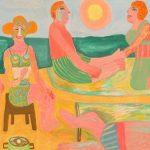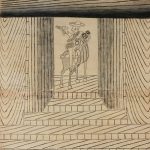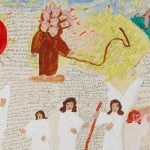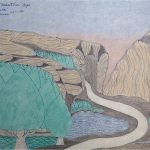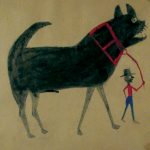Intuit defines outsider art as “the work of artists who demonstrate little influence from the mainstream art world and who are, instead, motivated by their unique personal visions.
The easiest way to understand what it means to be an outsider artist is to know how these artists are different from other artists you may have heard of or whose works you’ve seen before. What makes Henry Darger different from or the same as Andy Warhol or Pablo Picasso?
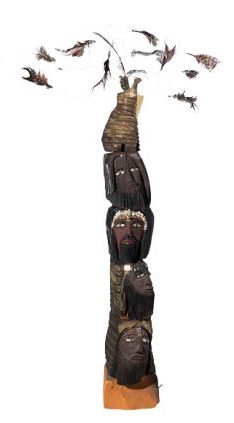
First, outsider artists have no formal training—meaning they did not attend art school or have academic art instruction. Many of these artists are not aware of artwork in museums or art galleries. Their work is created outside of mainstream fine art. Outsider artists simply create for themselves, in order to make sense of their experiences, interests and the world around them. Outsider artists engage with their surroundings on their own terms and do not follow the rules of the art world.
Second, outsider art is created for the self and not necessarily for an audience. When we think of artists, we might picture someone who paints or sculpts with the intention to sell the art. There is no fault in this; in fact, it is how most artists make a living. Many outsider artists, however, do not create with the intention of selling their work. Usually, they do not worry about what other people are going to think of their work.
Third, outsider artists are often motivated to create their work for different reasons than mainstream artists. Outsider artists make art for themselves, recording their life experiences and documenting historical events. Many outsider artists are known as visionary artists. Some create art because they believe they have received a message from God or some other spiritual or intelligence source. These artists have a strong inner vision and feel compelled to create their art. Often, the art is driven by impulse, obsession or religious inspiration.
Fourth, unlike many mainstream artists, outsider artists use non-traditional materials and found objects for their artwork. When visiting a museum, you will see hundreds of paintings on the walls that have been painted on a standard canvas with oil or acrylic paint. However, outsider artists tend to use non-traditional or repurposed materials, particularly when they don’t have access to art supplies. Outsider artists often use materials from their immediate surroundings—like their house, yard and neighborhood. They use objects that have been recycled or things we might throw away. The use of non-traditional or easily available materials is a frequent characteristic of outsider art.
Click any image below to see examples of outsider art.
While learning about outsider artists and looking at their work, consider what the artists might have been thinking or feeling when making their art. It is important to ask these questions:
- Why did the artist choose to create this piece?
- How and why did the artist use the materials?
- What is the artist trying to communicate through the artwork?
- What is the message or story of the artist?
Through questions like these and interpreting the art, you can have a better understanding of what it means to be an outsider artist and get a sense of the cultural significance of the genre.
For more information on how to analyze an artwork, please reference: www.terraamericanart.org/tools-for-teachers/discussing-art-and-common-core-anchor-standards
Excerpted from Intuit’s Henry Darger Resource Kit for Educators
Image credits:
Pauline Simon (American, 1894-1976). The Ocean (detail), n.d. Oil on canvas, 28 x 40 in. Collection of Intuit: The Center for Intuitive and Outsider Art, gift of Phyllis Kind, 2006.17.2
Martín Ramírez (American, born Mexico 1895–1963). Untitled (Horse and rider) (detail), ca. 1953. Graphite on pieced paper, 28 ½ x 24 in. Collection of Intuit: The Center for Intuitive and Outsider Art, Gift of Phyllis Kind, 2006.22.8
Sister Gertrude Morgan (American, 1900 -1980). Revelations (detail), ca. 1970. Pen, poster paint on paper, 22 in. x 28 in. Collection of Intuit: The Center for Outsider Art, Gift of Susann Craig, 2002.4
Joseph Yoakum (American, 1890-1972). Mt. Mourner in Maritine Alps near Diane France by Joseph E. Yoakum (detail), January 2, 1968. Colored pencil and ink on paper, 111/8 x 19 in. (30.16 x 19 cm). Collection of Intuit: The Center for Intuitive and Outsider Art, gift of Martha Griffin, 2014.5.1. Photo © John Faier
Bill Traylor (American, 1853-1949). Untitled (Man leading black dog) (detail), ca. 1939-42. Mixed media on board, 15 x 14 3/4 in. Collection of Intuit: The Center for Intuitive and Outsider Art, Promised gift of Jan Petry and Angie Mills, P24.2004

